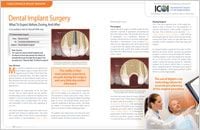Often, people who are missing teeth look older than they really are. The reason is the loss of jawbone that inevitably follows tooth loss.
Bone needs stimulation to maintain its form and density. In the case of the jawbone, that stimulation comes from the teeth, which make hundreds of fleeting contacts with each other throughout the day. The small stresses produced by these contacts are transmitted to the bone, prompting it to regenerate constantly.
When a tooth is lost, the stimulation it provided disappears. In just the first year of tooth loss, there is a 25% decrease in bone width. This is followed over the next few years by an overall 4 millimeters decrease in height. If enough teeth are lost, and as bone loss continues, the distance from nose to chin can decrease and the lower third of the face partially collapses. With a lack of structural support, the lips sag; that's why toothless people often appear unhappy as well as prematurely aged. Extreme loss of bone can also make an individual more prone to jaw fractures.
One may also find that some of the remaining teeth actually shift into the spaces left open by missing teeth. This in turn can cause additional bite problems and even jaw joint (TMJ) pain. Finally, compromised nutrition and poor general health can result if eating healthy foods like raw fruits and vegetables becomes too difficult without teeth.
Now here's the good news: Dental implants — the state-of-the-art tooth-replacement method preferred by dentists — can prevent all this. Besides helping a person without teeth look and feel great again, dental implants actually prevent bone loss. That's because they are made of titanium, which has a unique ability to fuse to living bone. By actually becoming a permanent part of the jawbone, dental implants stabilize and stimulate the bone to maintain its volume and density.
Dental implants are placed during a minor in-office surgical procedure using local anesthetic and then, either immediately or after a healing period, topped with lifelike dental crowns. Together, these precision components look, feel and function exactly like your natural teeth. Dental implant success rates exceed 95% — the highest of any tooth-replacement option. With regular brushing, flossing, and professional cleanings — in other words, the same basic care that natural teeth require — your dental implants should last a lifetime.
Related Articles

The Hidden Consequences of Losing Teeth For those missing even one tooth, an unsightly gap is actually the least significant problem. What's of far greater concern is the bone loss that inevitably follows tooth loss. Dental implants can preserve bone, improve function and enhance psychological well-being. Learn how implants serve both as anchors to support replacement teeth and preserve bone... Read Article

Dental Implant Surgery Many people are surprised at how relatively easy dental implant surgery is because they let their imaginations get the better of them before they go through the actual procedure. The reality is that most patients experience no pain during the surgery and very little discomfort afterward. Let's back up and start with the basics to increase your understanding and allay any apprehension... Read Article

